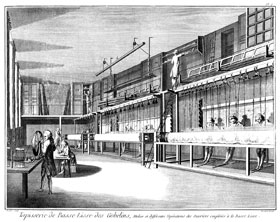The techniques of Tapestry at the Gobelins works
Denis Diderot et Jean Le Rond d’Alembert
Encyclopédie ou Dictionnaire raisonné des sciences, des arts et des métiers, par une société des gens de lettre
Paris, Briasson, David, Le Breton, Durand, t. IX, 1771.
Floirac, Bibliothèque municipale, fonds patrimoniaux, A 617/24.
Fonds ancien Bouguer
Robert Bernard, d’après Radel
Tapisserie de haute-lisse des Gobelins
plan et perspective de l’atelier, des métiers et différentes opérations.
Denis Diderot et Jean Le Rond d’Alembert
Encyclopédie ou Dictionnaire raisonné des sciences, des arts et des métiers, par une société des gens de lettre
Paris, Briasson, David, Le Breton, Durand, t. IX, 1771.
Collection particulière

© Collection particulière.
These two plates from Diderot and d’Alembert’s Encyclopédie illustrate the making of a tapestry in the middle of the 18th century, as it was already being practised at the Manufacture des Gobelins in 1685.
The term tapestry describes a textile furnishing made by hand or on a loom, in which the design is created at the same time as the fabric itself.
The function of the loom is to stretch the warp yarns between two large rollers, the beams, to allow the passage of the weft yarns which will form the design. In the 17th century, there were two types of loom: the high-warp loom and the low-warp loom. The basic difference between the two is the direction of the warp yarns.
- On a low-warp loom, the warp yarns are stretched horizontally between two beams, facing the weaver. The warp yarns are lifted alternately to create a "shed" between them. They pass through a series of heddles, which are connected to a pedal under the loom. The weaver treads on the two pedals alternately to cross or separate the two rows of yarns.
- On a high-warp loom, the warp yarns are stretched vertically between two beams, in front of the weaver. High-warp weaving tends to be less precise than low-warp weaving.
There were four tapestry studios in the Gobelins works: four containing high-warp looms and one low-warp looms. At the head of the first studio was Jean Jans, who came from Bruges in Flanders. When Charles Le Brun became director of the Gobelins in 1664 he launched an intense activity, dedicated entirely to celebrating the glory of Louis XIV. He had cycles such as The Elements and The Seasons woven, which met with great success. But the most famous series remains without doubt The History of the King, commissioned by the King himself...
The rest of the exhibition is upstairs. You can take the stairs or the lift, which you will find in the corridor to the right of the staircase.
